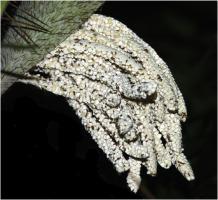Our official English website, www.x-mol.net, welcomes your feedback! (Note: you will need to create a separate account there.)
Pollination of Bactris guineensis (arecaceae), a potential economically exploitable fruit palm from the Colombian Caribbean
Flora ( IF 1.9 ) Pub Date : 2020-08-01 , DOI: 10.1016/j.flora.2020.151628 Edwin Brieva-Oviedo , Artur Campos D Maia , Luis Alberto Núñez-Avellaneda
Flora ( IF 1.9 ) Pub Date : 2020-08-01 , DOI: 10.1016/j.flora.2020.151628 Edwin Brieva-Oviedo , Artur Campos D Maia , Luis Alberto Núñez-Avellaneda

|
Abstract Regardless of the ecological and economical importance of palms, their pollination strategies and the identities of their true pollinators are still contentious subjects. Bactris guineensis grows in open areas in lowland Caribbean Colombia. Its fruits have long been an important component of local economy and are now targeted for broader scale production for the Colombian market. We explored details of the reproductive biology of B. guineensis in its natural environment to understand the various elements of pollen flow dynamics that ensure optimal fruit yield. During two consecutive years, we investigated the phenology, floral biology and pollination ecology of a wild population of B. guineensis in the department of Sucre, northern Colombia. Monthly production of buds, inflorescences and ripe infructescences were quantified. Pollen carrying capacity, efficiency and fidelity of anthophilous insect species associated with B. guineensis were calculated and used to define their role as effective pollinators. Bactris guineensis is protogynous and exhibits ephemeral nocturnal anthesis. In spite of strict xenogamy the average reproductive success was over 75%, attributed to high pollen vector efficiency. Twenty-seven insect species representing three orders were recorded as floral visitors, but the only effective pollinators were minute flower weevils and sap beetles. At the beginning of the female phase of anthesis, when pistillate flowers are receptive, inflorescences of B. guineensis warm up to over 12 °C above ambient air and emit a balsamic scent, attracting swarms of several hundred to thousands of beetles loaded with pollen. A second, shorter-lasting floral heating event takes place by dusk in the following day (or the male phase), which culminates with pollen shedding of staminate flowers and departure of the pollinators. Anthesis events that are highly synchronized with activity patterns of specialized scent-oriented pollinators ensure the high reproductive success of B. guineensis at our study site. Plans for large scale production should prioritize insect-friendly practices and investigation on the role of volatile floral kairomones for pollinator attraction.
中文翻译:

Bactris guineensis(槟榔科)的授粉,一种来自哥伦比亚加勒比地区的潜在经济上可开发的果树
摘要 不管棕榈树在生态和经济上的重要性如何,它们的授粉策略和真正授粉者的身份仍然是有争议的话题。Bactris guineensis 生长在哥伦比亚加勒比海低地的开阔地区。长期以来,其果实一直是当地经济的重要组成部分,现在针对哥伦比亚市场进行更大规模的生产。我们探索了 B. guineensis 在其自然环境中的生殖生物学细节,以了解确保最佳果实产量的花粉流动动力学的各种要素。在连续两年中,我们调查了哥伦比亚北部苏克雷省的 B. guineensis 野生种群的物候学、花卉生物学和授粉生态学。对芽、花序和成熟果序的月产量进行量化。计算与 B. guineensis 相关的 anthophilous 昆虫物种的花粉承载能力、效率和保真度,并用于定义它们作为有效传粉者的作用。Bactris guineensis 是雌性的并且表现出短暂的夜间开花。尽管实行严格的异种婚配,但由于花粉载体效率高,平均繁殖成功率超过 75%。代表三个目的 27 种昆虫被记录为花客,但唯一有效的传粉媒介是微小的花象鼻虫和树液甲虫。在雌性开花期开始时,当雌花能接受时,金龟子的花序会升温至高于环境空气 12 °C 以上并散发出香脂气味,吸引成群结队的数百至数千只装满花粉的甲虫。一秒,持续时间较短的花卉加热事件发生在第二天的黄昏(或雄性阶段),以雄花的花粉脱落和传粉媒介的离开而告终。与专门的以气味为导向的传粉者的活动模式高度同步的开花事件确保了我们研究地点的 B. guineensis 的高繁殖成功率。大规模生产的计划应优先考虑对昆虫友好的做法,并调查挥发性花卉 kairomones 在吸引传粉媒介方面的作用。guineensis 在我们的研究地点。大规模生产的计划应优先考虑对昆虫友好的做法,并调查挥发性花卉 kairomones 在吸引传粉媒介方面的作用。guineensis 在我们的研究地点。大规模生产的计划应优先考虑对昆虫友好的做法,并调查挥发性花卉 kairomones 在吸引传粉媒介方面的作用。
更新日期:2020-08-01
中文翻译:

Bactris guineensis(槟榔科)的授粉,一种来自哥伦比亚加勒比地区的潜在经济上可开发的果树
摘要 不管棕榈树在生态和经济上的重要性如何,它们的授粉策略和真正授粉者的身份仍然是有争议的话题。Bactris guineensis 生长在哥伦比亚加勒比海低地的开阔地区。长期以来,其果实一直是当地经济的重要组成部分,现在针对哥伦比亚市场进行更大规模的生产。我们探索了 B. guineensis 在其自然环境中的生殖生物学细节,以了解确保最佳果实产量的花粉流动动力学的各种要素。在连续两年中,我们调查了哥伦比亚北部苏克雷省的 B. guineensis 野生种群的物候学、花卉生物学和授粉生态学。对芽、花序和成熟果序的月产量进行量化。计算与 B. guineensis 相关的 anthophilous 昆虫物种的花粉承载能力、效率和保真度,并用于定义它们作为有效传粉者的作用。Bactris guineensis 是雌性的并且表现出短暂的夜间开花。尽管实行严格的异种婚配,但由于花粉载体效率高,平均繁殖成功率超过 75%。代表三个目的 27 种昆虫被记录为花客,但唯一有效的传粉媒介是微小的花象鼻虫和树液甲虫。在雌性开花期开始时,当雌花能接受时,金龟子的花序会升温至高于环境空气 12 °C 以上并散发出香脂气味,吸引成群结队的数百至数千只装满花粉的甲虫。一秒,持续时间较短的花卉加热事件发生在第二天的黄昏(或雄性阶段),以雄花的花粉脱落和传粉媒介的离开而告终。与专门的以气味为导向的传粉者的活动模式高度同步的开花事件确保了我们研究地点的 B. guineensis 的高繁殖成功率。大规模生产的计划应优先考虑对昆虫友好的做法,并调查挥发性花卉 kairomones 在吸引传粉媒介方面的作用。guineensis 在我们的研究地点。大规模生产的计划应优先考虑对昆虫友好的做法,并调查挥发性花卉 kairomones 在吸引传粉媒介方面的作用。guineensis 在我们的研究地点。大规模生产的计划应优先考虑对昆虫友好的做法,并调查挥发性花卉 kairomones 在吸引传粉媒介方面的作用。



























 京公网安备 11010802027423号
京公网安备 11010802027423号